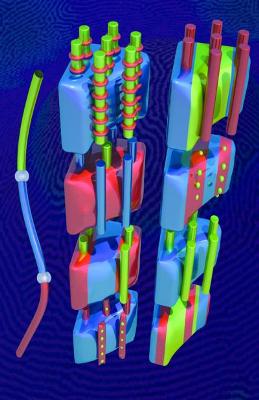A paper titled, ‘Multiblock Polymers: Panacea or Pandora's Box?,’ describes how a wide range of monomers can be used to create multiblock polymers that can lead to an array of materials with different properties.
 The variety of monomers that can be used to construct multiblock polymers can yield a multitude of materials with different properties.
The variety of monomers that can be used to construct multiblock polymers can yield a multitude of materials with different properties.
The authors of the research paper areKris Delaney and Glenn Fredrickson from UC Santa Barbara. Polymers are large molecules, which are made of series of monomers. Different types of monomers are chemically bound to form blocks, which are known as multiblock polymers and these polymers can be used in a multitude of materials that are suitable for applications, such as solar cells and tennis shoes. In 1950's, researchers had a limited number of monomersand techniques to produce multiblock polymers. With the advancement of the polymer science, Scientists can now produce materials using monomers from various sources, ranging from petroleum to renewable feedstocks, like cellulose and sugar.
A professor of chemical engineering at UC Santa Barbara, Glenn Fredrickson, stated that the Pandora's box is where several monomers can be put together in a variety of block sequencesand the properties of the monomers will vary depending on the sequence and interactions among the blocks. As multiblock polymers can self-assemble into nano-sized domains, they can reveal amazing properties, such as elastic, strong and soft. A major issue in the development of the multiblock polymers is the determination of thenumber of combinations of different species of monomers. To overcome this problem,UC Santa Barbarascientists along with researchers from the University of Texasand the University of Minnesota suggest an approach that combines predictive computer simulation techniques with state-of-the-art structural characterization tools. Currently, the UC Santa Barbara scientists are collaborating with Intel to create multiblock polymers for higher-tech applications.
Source: http://www.ucsb.edu/